The three main macronutrients that are relatable to a keto diet are fats, proteins, and carbohydrates. All three of these nutrients have different effects on ketosis because of how our body digests and metabolizes them.
- Fats are 90% ketogenic and 10% anti-ketogenic, due to the small amount of glucose that is released in the conversion of triglycerides into usable energy.
- Proteins are roughly ~46% ketogenic and 58% anti-ketogenic since insulin levels usually rise in response to the absorption of specific amino acids. Insulin indirectly decreases ketone production.
- Carbohydrates are, of course, 100% anti-ketogenic, as they raise both blood glucose and insulin – two key factors that trigger a decrease in ketone production.
Because of their anti-ketogenic activity, protein and carbohydrates will impact our ketone levels and make it harder for us to transition into ketosis. However, the most important thing to understand is how these nutrients are being utilized for energy via our metabolic pathways.
Metabolic Pathways
So, what exactly do I mean by metabolic pathways? Put simply, they are the mechanisms by which the body digests and uses fats, proteins, and carbohydrates depending on its current “state.”
These “states” can be broken down into three main categories:
- Fed – Right after a complete meal.
- Fasting – When we haven’t eaten in 2-8 hours.
- Starved – When haven’t eaten in more than 24 hours.

Fed State
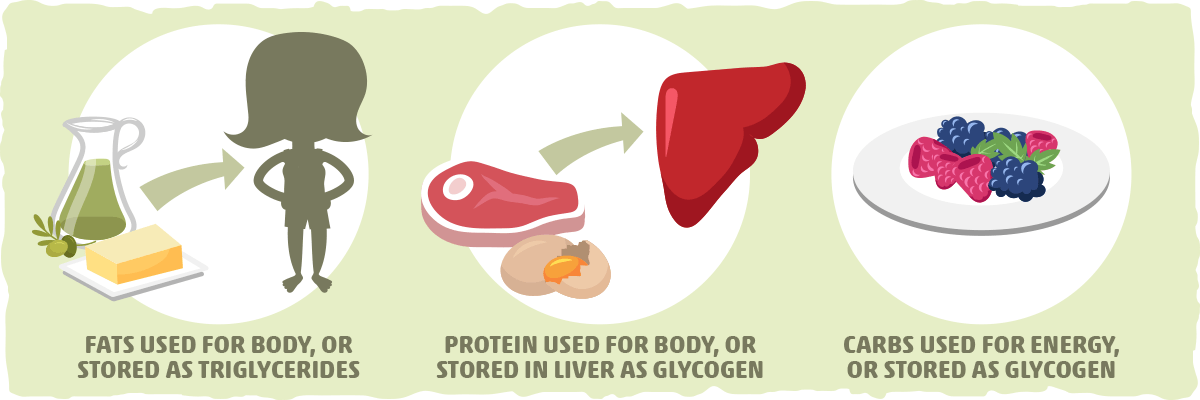
In the fed state (i.e., after we eat a complete meal), the macronutrients we consume are broken down through separate metabolic pathways:
- The fats we eat, except for medium-chain triglycerides, enter the bloodstream through the lymphatic system. Once they enter our circulation, the fats are sent around the body to provide fuel for our heart and other tissues, repair cells, and make different chemicals, hormones, and tissues in the body. Excess fats are stored as triglycerides in the fat cells throughout the body.
- Proteins are processed into amino acids through a process called transamination and sent off to create neurotransmitters, enzymes, non-essential amino acids, and other protein-based compounds. If we have any extra amino acids, they circulate and repair tissue or get converted into glucose and stored as glycogen (our storage form of glucose).
- Most of the carbohydrates we consume are broken down into glucose which is used as an immediate energy source. When our glucose levels increase, the pancreas secretes insulin into the blood. This helps shuttle the glucose into our cells to be used as energy or stored as glycogen or fat for future use.
The fasting state occurs when our blood glucose is at a borderline level, which also means our insulin levels are decreased. With this drop in blood glucose, insulin’s opposing hormone, glucagon, will be secreted, triggering the release of stored fuel from glycogen and fat cells.
Fasting State
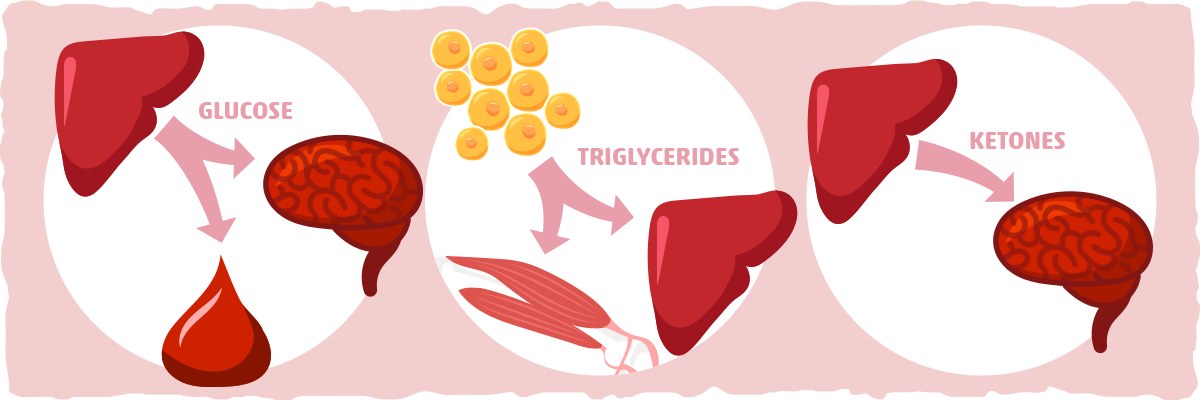
In a fasting state, our stored energy sources, such as glycogen, fat, and muscle, are broken down by different processes and metabolized into the same fuel. Each one is converted into acetyl-CoA, which is an important part of creating ATP (our primary energy shuttling molecule) in the Kreb’s Cycle.
When liver glycogen is released, glucose levels increase in the bloodstream. In turn, this glucose is primarily used by the brain and red blood cells.
Free fatty acids are released from the fat cells that are in the form of triglycerides. These are the primary fuel source for the liver and muscles while we are sleeping or doing low-intensity exercise like walking.
The liver will also form ketones from these fatty acids, which our brain uses for fuel when blood sugar isn’t available in abundance (our brain cells don’t use fatty acids for fuel). More fatty acids from stored fat enter the circulation, and more ketones are produced the longer we stay in a fasted state.
Starved State
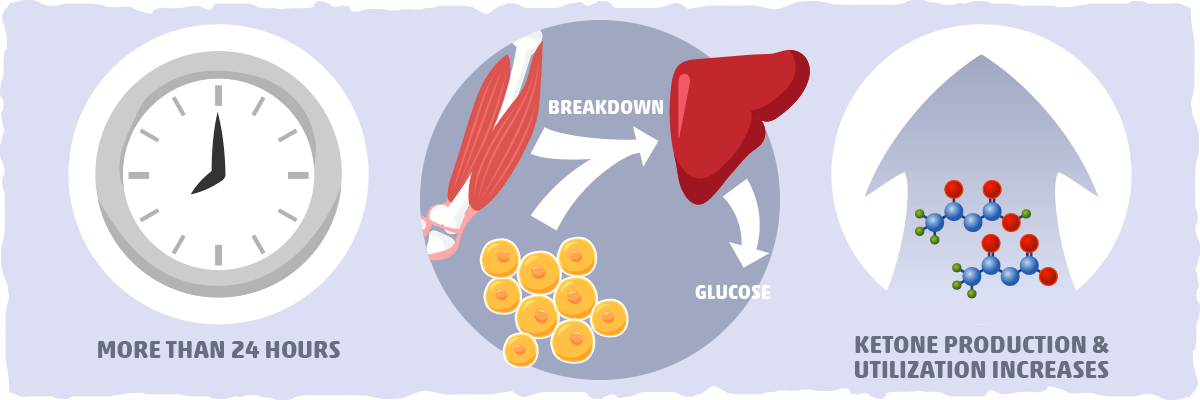
Once we have been in a fasting state for longer than 24 hours, we transition into a starved state. The glycogen in our muscles and liver will run out.
The liver will begin to break down lactate, amino acids (from muscle), and glycerol (from stored fat) to create more glucose to meet the sugar needs that ketones cannot help with.
Ketone production and utilization will start to increase significantly until it supplies around 50% of the body’s basal energy requirements and 70% of the brain’s energy needs. This will help prevent excess muscle loss and maintain cognitive function when calorie intake is significantly restricted.
How does this all relate back to the keto diet? By restricting carbs, we are essentially mimicking a starved state without actually starving ourselves. Without a regular influx of dietary carbs, the body will have to adapt by becoming a fat and ketone burning machine.
However, since the keto diet allows you to consume plenty of nutrients, you will not have to experience the muscle loss or unhealthy decreases in metabolic rate that occur as a result of actual starvation.
In other words, keto dieting allows us to experience the benefits of carb restriction and ketones without having to starve ourselves.
At first, following a keto diet can be a bit tricky. To get into ketosis, you must eat the right amount of carbs, fats, and protein based on your needs, activity levels, and goals. This can be a lot to balance when you are first starting out, so let’s take a closer look at each macronutrient one by one and make them easier digest.
Protein and the Keto Diet
Protein plays a vital role in every diet, but it can be a confusing nutrient while you are on the keto diet. If you don’t eat enough protein, you will lose muscle mass. You might be thinking “well, I can just eat more and more meat to keep my muscle as I lose the fat.” Well, that would be pretty delightful, but consuming massive amounts of protein can also raise insulin levels to the point that it kicks you out of ketosis.
As we learned earlier in this post, protein is 46% ketogenic and 54% anti-ketogenic, meaning that too much of the stuff can decrease ketone production. We have to fall between narrow ranges in our protein intake: enough to maintain or gain muscle mass without impairing ketone production.
This narrow range is quite hard to determine, as it varies from person to person based on their body composition goals, activity levels, current body composition, and body weight. Some have reported trouble maintaining ketosis if they eat excessive protein in a single day, or if they eat too much protein in 1 sitting. Others can have more than 1.2g of protein per pound of body weight and experience no issues with transitioning into and staying in ketosis.
After digging through the research on protein intake, we’ve found these ranges to work best for most people:
- Sedentary: 0.8g of protein per pound of lean body mass.
- Lightly Active: 0.8 – 1.0g of protein per pound of lean body mass.
- Highly Active: 1.0 – 1.2g of protein per pound of lean body mass.
In general, I recommend trying to get away with eating as much protein as you can (I.e., stay around the higher end of your protein intake range). This may be a striking suggestion after learning that protein has anti-ketogenic properties, but we mustn’t forget about the other benefits that protein can have for us.

The Importance of Protein for Your Health and Diet Success
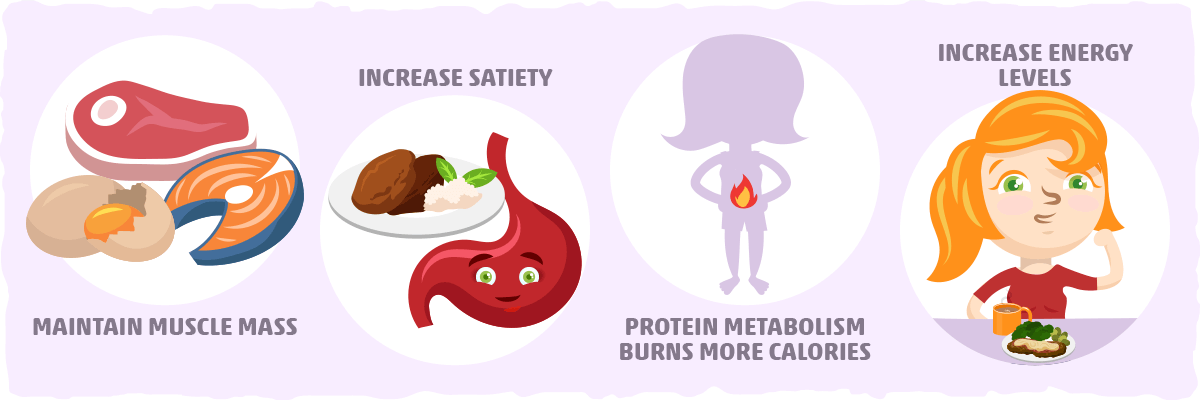
Getting the right amount of protein every day plays a crucial role in the results you get. Here is a list of the main benefits that adequate protein intake can have for you:
- Maintain (or gain, if you do resistance training) muscle mass. Want to lose fat without burning off your muscle along with it? Eat plenty of protein and make sure you exercise throughout the week. Both play an essential role in chiseling your body into shape.
- Decrease cravings and increase your feelings of fullness. Some research suggests that protein is the most satiating macronutrient, which means that it can help you eat fewer calories and lose weight without having to fight against hunger and cravings. In other words, by increasing your protein intake, you can make your diet much easier to sustain and your results much easier to attain.
- Burn more calories than you would while eating an equal amount of fat or carbs. Protein metabolism requires much more energy than fat or carb metabolism. This means that your body has to burn more calories in order to make use of the protein you consume, making it less fattening than the other macronutrients.
- Increase energy levels. Despite the fact that you will be burning ketones for fuel, your body is still going to need some sugar to energize certain cells and metabolic processes. Fortunately, you can provide your body with sugar without eating it. How is this possible? Via a process called gluconeogenesis. During this metabolic process, your liver helps turn specific amino acids from protein into sugar. If you eat enough protein, it will be turned into sugar and stored as glycogen that can help increase your energy levels.
Altogether, these benefits will help enhance your weight loss results while making it much easier for you to stick to the keto diet for the long term. As soon as you figure out how to reap these benefits (by using our keto calculator and/or experimenting with different protein intake levels), you will be ready for the next step: meeting your daily protein needs.
How to Get Enough Protein While Following the Keto Diet
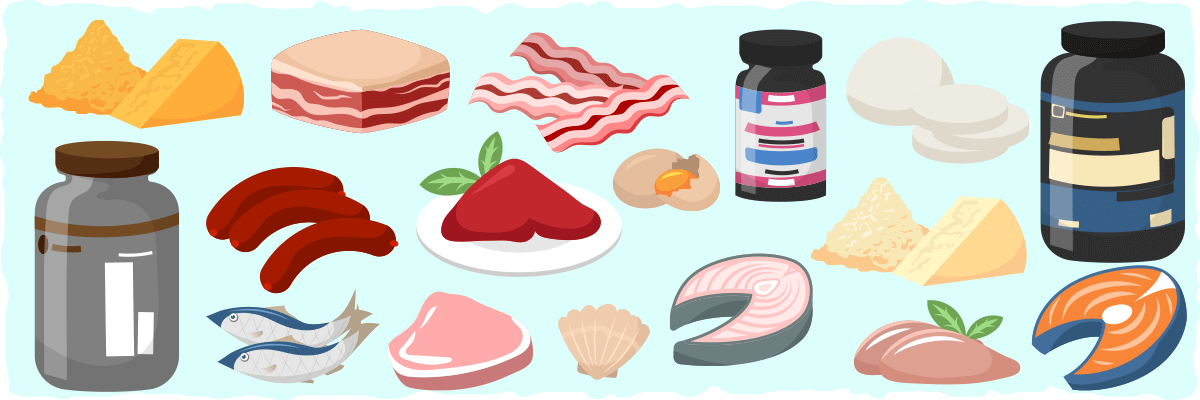
Need help meeting your protein needs while keeping your carbs low? Add one or more of these keto-approved protein sources to your meals:
- Fish. Preferably eating anything that is caught wild like catfish, cod, flounder, halibut, mackerel, mahi-mahi, salmon, snapper, trout, and tuna. Fattier fish is better.
- Shellfish. Clams, oysters, lobster, crab, scallops, mussels, and squid.
- Whole Eggs. Try to get them pasture-raised from the local market if possible. You can prepare them in any way you’d like.
- Stick with fattier cuts and 100% grass-fed when possible.
- Pork. Ground pork, pork loin, pork chops, tenderloin, and ham. Watch out for added sugars and try to stick with fattier cuts.
- Poultry. Chicken, duck, quail, turkey, pheasant and other wild poultry.
- Organ Meat. Heart, liver, kidney, and tongue. Offal is one of the best sources of vitamins, antioxidants, and minerals.
- Unconventional Meat Veal, goat, lamb, and other wild game. Stick with fattier cuts when possible.
- Bacon and Sausage. Check labels for anything cured in sugar, or if it contains extra fillers. Don’t be overly concerned with nitrates.
- Cheese. Cheddar, mozzarella, parmesan, and other hard cheeses. Always purchase full-fat cheeses.
- Keto-Friendly Protein. 100% grass-fed whey protein, collagen protein, casein protein, pea protein isolate, and any other very low-carb protein powders.
For those of you who are trying to cut down on any animal products, please check out our guide to vegan keto dieting. There you’ll find plenty of vegan-friendly protein sources as well.
However, as you munch on these delicious, keto-friendly protein sources, don’t forget about your ketone levels. As we learned earlier, protein has anti-ketogenic properties.
For the most part, if you stick to the recommended protein intake ranges, you should be able to get into and stay in ketosis without any issues. On the other hand, for those of you who are struggling with keto or want to learn more about protein and ketosis, I suggest check out our in-depth article on the topic.
Fats and the Ketogenic Diet
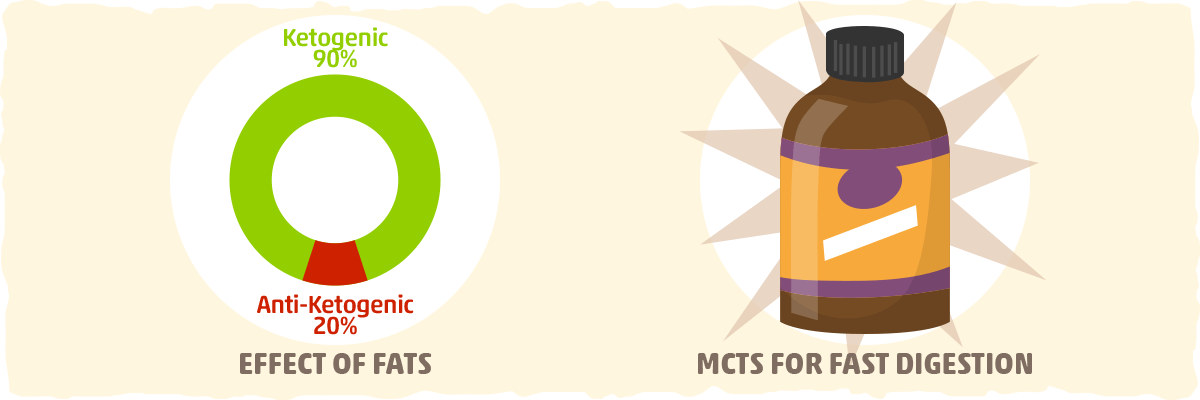
Fats are 90% ketogenic and only 10% anti-ketogenic, so we can get away with significant amounts of fat intake without it having any impact on our ketone levels.
Yes, the glycerol from triglycerides can be converted into glucose, but this will have a negligible effect on ketosis at most. Since fats are mostly consumed over the entire day and not just in 1 sitting, your body will be using the glucose that can be produced from glycerol without you even noticing it’s there.
The only time in the day that you may have to deviate from a consistent fat intake is after a workout. Fats slow down the digestion process and will slow the absorption of the protein you intake after your workout, so they’re not recommended.
With that being said, you can get away with consuming fat after (or before or during) your workouts as long as that fat is coming from medium chain triglycerides (MCTs). MCTs are digested so rapidly that they will not slow protein absorption.
How to Figure Out Your Fat Needs and Meet Them
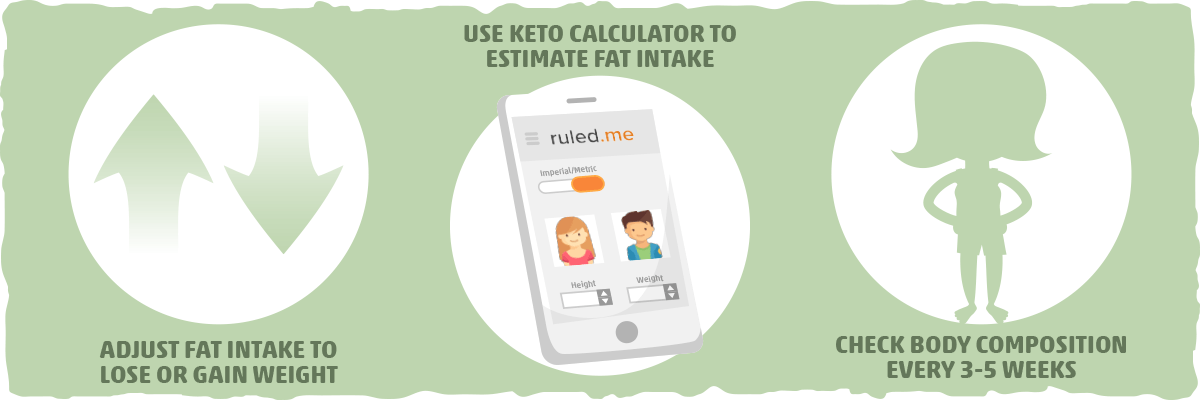
Since fat will be your primary source of calories on the keto diet, you will have to increase or decrease your fat intake to manipulate the rate at which you gain or lose weight.
Although you can guesstimate how much fat you need to eat based on the results you get, I recommend using our keto calculator as a starting point. It will give you an estimated fat intake goal based on your height, weight, gender, activity levels, and goals.
By staying relatively close to what the calculator suggests, you should be able to get the results you are looking for. To ensure that you are on the right track, check your body composition after 3-5 weeks and follow the recommendations from our article titled “How Much Fat Should You Eat on a Ketogenic Diet” if you are not getting the results you want. In that article, you will also find plenty of information and strategies that will help you meet your fat needs.
Carbohydrates on Keto
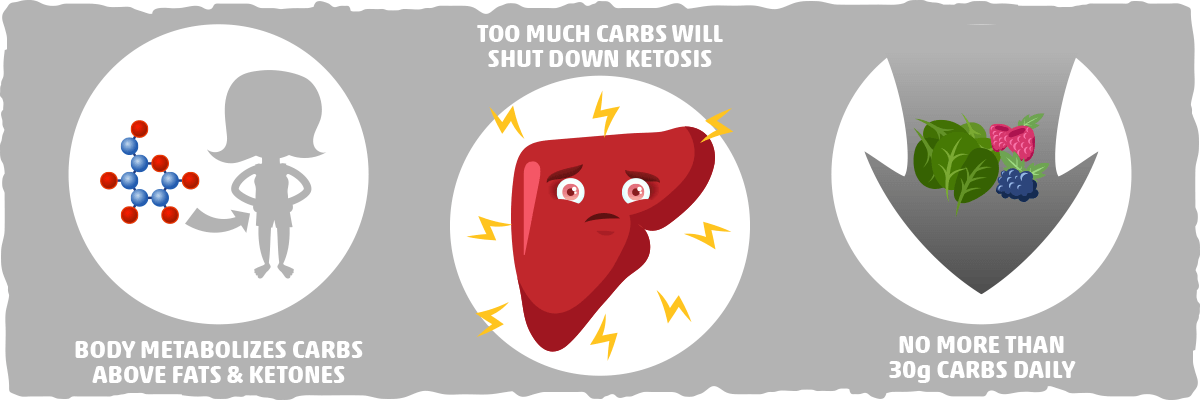
Carbs have the most profound effect on ketosis out of every macronutrient. When we ingest carbohydrates, our bodies will metabolize it first regardless of how much fat or ketones we are burning at the time. In fact, the amount of fat and ketones that you burn will decrease as your carb consumption increases.
This occurs because carbs are broken down into glucose, which can be used by almost every cell in the body as soon as its needed. When enough glucose is available, the liver will stop producing ketones and focus on processing the sugars as a way to prevent an accumulation of too many energy substrates.
To ensure that your daily food intake doesn’t get in the way of ketone production, the general rule is to consume no more than 30g of carbs a day. Although you can eat slightly more carbs and stay ketosis, 30 grams is generally a good place to start for most people. If you’d like to learn how to adjust your carb intake without impairing your keto diet results, I recommend checking out our article titled “How To Find Your Ketogenic Diet Carb Limit.”
But Won’t Fat Make You Fat? What About Carbs? The Science Behind Fat, Carbs, Weight Gain, and Weight Loss
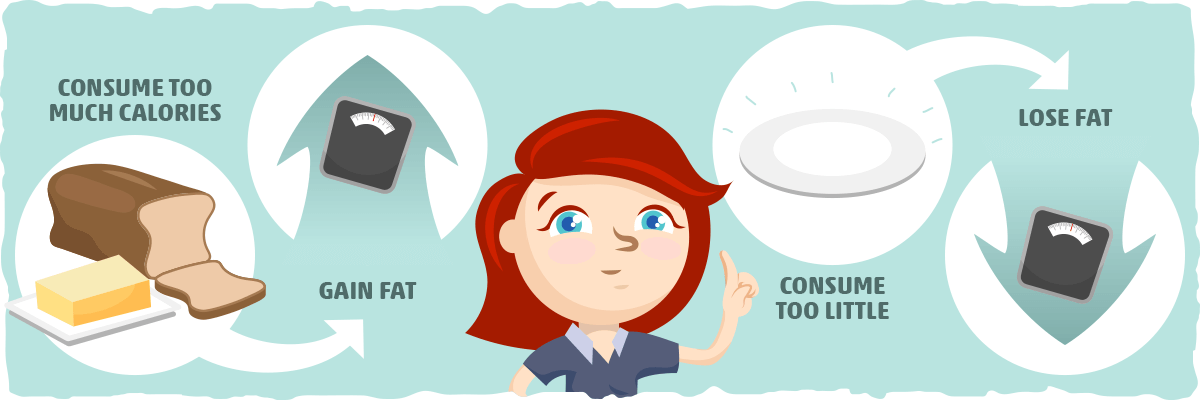
The complex question of what causes us to lose and gain fat has been hotly debated for decades. Obesity is still on the rise in many westernized countries, and the current diet advice doesn’t seem to be helping.
One side of the spectrum claims that fat consumption is to blame. After all, fat is a whopping 9 calories per gram, and since it is already made of fat, it can easily be stored in our fat cells, right?
On the other side stands the hypothesis that carbs are the culprit. More specifically, when we eat excess sugar, we cause a massive insulin spike that tells our fat cells to store fat. As insulin levels stay high (as a result of a high carb diet), it prevents us from burning our stored fat for fuel and losing weight.
Both sides of the spectrum sound like they could be true, and to some degree, they are both right. Yes, fat CAN make you fat. There are biological mechanisms that turn the components of the fat we eat into stored fat.
However, this doesn’t mean that carbs can’t provoke fat storage as well. In fact, carbs can both provoke fat storage and be converted into fat.
When we look at the issue of weight loss and weight gain from another angle, dozens of high-quality studies show that both low-carb and low-fat diets can be used to help us lose fat. In fact, meta-analyses have found that there isn’t much difference in weight loss between the two diets after a year. Interesting, right?
The one variable that can help us bring the biological mechanisms and research data together is calorie consumption. Although it isn’t an exact science, the calories we eat and burn play the most significant role in determining whether or not we gain or lose weight.
In other words, fat and carbs don’t make you fat, but they can be stored as fat. What determines if they are stored as fat is the energy needs of your body at the time those macronutrients are consumed.
In general, when we are in calorie excess (i.e., we consume more energy than our body needs to maintain its weight and metabolic functions at any given time), we will tend to store them as fat for later use. Whether carbs or fat will be stored as fat depends on the content of your diet.
As an example, if you were to eat absolutely no carbs at all, yet consume so much fat that you were in a calorie excess, then you would store that fat as fat. The fat didn’t make you fat, your excess energy intake did.
The same holds true if you were to eat a ridiculous amount of carbs and no fat at all. Those carbs would eventually be stored as fat, not because carbs are a fattening macronutrient, but because being in a calorie excess is literally fattening.
Wow! That was a lot of science. Let’s see if we can distill all of this down into practical strategies you can use to help you lose weight with keto.
Practical Applications – How to Eat the Right Macros to Get the Results You Want with the Keto Diet
Your easiest option is to use our keto calculator to provide you with an estimate of your recommended macronutrient intake. To help you keep track of how much you are actually eating, we recommend using a calorie tracker like MyFitnessPal or Cronometer. If you need help setting it up check out our step by step guide on how to track carbs (and calories) on keto.
For those of you would like to dive deeper into each macronutrient, you will probably find what you are looking for in these articles:
- How Much Fat Should You Eat on a Ketogenic Diet?
- Is Too Much Protein Bad for Ketosis? The Truth Behind How Much Protein You Need on Keto
- How To Find Your Ketogenic Diet Carb Limit
Sources:
- Ketosis and The Ketogenic Ratio – Body Recomposition
- A model for determining total ketogenic ratio (TKR) for evaluating the ketogenic property of a weight-reduction diet – Science Direct
- Ketogenic Ratio, Calories and Fluids: Do They Matter? – NCBI
- The effects of high protein diets on thermogenesis, satiety and weight loss: a critical review. – NCBI
- Diet induced thermogenesis – NCBI
- Optimising foods for satiety – Science Direct
- The regulation of ketogenesis. – NCBI
- Intestinal lipid absorption – NCBI
- Digestion and absorption of fats – University of Washington
- What is Ketosis? – Ruled.me
- Keto & Weight Loss — ruled.me
- Obesity Energetics: Body Weight Regulation and the Effects of Diet Composition. — NCBI
- Effects of low-carbohydrate vs low-fat diets on weight loss and cardiovascular risk factors: a meta-analysis of randomized controlled trials — NCBI Bookshelf
- Very-low-carbohydrate ketogenic diet v. low-fat diet for long-term weight loss: a meta-analysis of randomised controlled trials — British Journal of Nutrition
- Effect of 6-month calorie restriction on biomarkers of longevity, metabolic adaptation, and oxidative stress in overweight individuals: a randomized controlled trial. — NCBI
- Effect of Protein Intake on Strength, Body Composition and Endocrine Changes in Strength/Power Athletes — NCBI
- Dietary Guidelines should reflect new understandings about adult protein needs — NCBI
- Skeletal muscle metabolism is a major determinant of resting energy expenditure. — NCBI
- Controversies in Metabolism — The University of New Mexico
- Factors determining energy expenditure during very-low-calorie diets. — NCBI
- A systematic review of dietary protein during caloric restriction in resistance trained lean athletes: a case for higher intakes. — NCBI
- Energy expenditure before and during energy restriction in obese patients. — NCBI
- Adaptive thermogenesis in humans — NCBI
